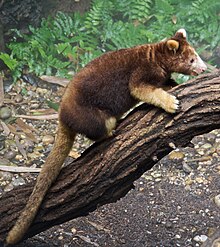
Papua New Guinea together with the West Papua region of Indonesia (New Guinea) make up a major tropical wilderness area that still contains 5% of the original and untouched tropical high-biodiversity terrestrial ecosystems.[1] PNG in itself contains over 5% of the world's biodiversity in less than 1% of the world's total land area.[2] The flora of New Guinea is unique because it has two sources of origin; the Gondwana flora from the south and flora with Asian origin from the west.[3] As a result, New Guinea shares major family and genera with Australia and the East Asia, but is rich in local endemic species. The endemicity is a result of mountainous isolation, topographic and soil habitat heterogeneity, high forest disturbance rates and abundant aseasonal rainfall year round. PNG boasts some 15–21,000 higher plants, 3,000 species of orchids, 800 species of coral, 600 species of fish, 250 species of mammals and 760 species of birds and 8 species of tree-kangaroos[4] out of which 84 genera of animals are endemic. Ecosystems range from lowland forests to montane forests, alpine flora down to coastal areas which contains some of the most extensive pristine mangrove areas in the world. Much of this biodiversity has remained intact for thousands of years because the ruggedness of the terrain made the interior lands inaccessible; furthermore low population density and restrictions on the effectiveness of traditional tools, ensured that these biodiversity was never overexploited.
- ^ Mittermeier, Russell A.; Myers, Norman; Thomsen, Jorgen B.; da Fonseca, Gustavo A. B.; Olivieri, Silvio (1998). "Biodiversity Hotspots and Major Tropical Wilderness Areas: Approaches to Setting Conservation Priorities". Conservation Biology. 12 (3). Society for Conservation Biology: 516–20. doi:10.1046/j.1523-1739.1998.012003516.x. ISSN 1523-1739. JSTOR 2387233. S2CID 85717165.
- ^ AUSAID, 2005, Australian Government Overseas Aid Available at "About Papua New Guinea". Archived from the original on 2011-05-18. Retrieved 2011-05-05.
- ^ Beehler B.M 1993 (ed) Papua New Guinea Conservation needs analysis Volume 2, Papua New Guinea Department of Environment and Conservation.
- ^ Newell G.R., 1999. Australia's tree-kangaroos: current issues in their conservation. Biological Conservation, Elsevier Science 87, (1), pp: 1-12. Available online,